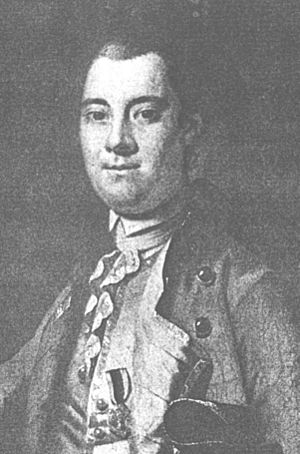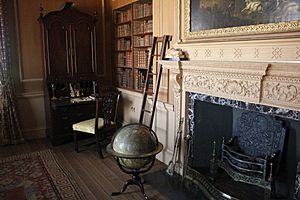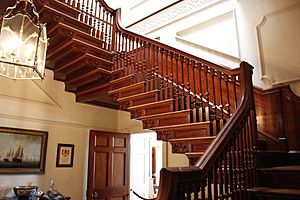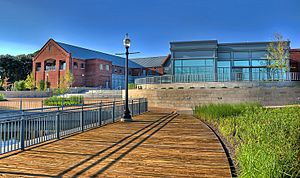Tryon Palace facts for kids
Quick facts for kids Tryon Palace |
|
|---|---|

Main façade of Tryon Palace
|
|
| Alternative names | Governor's House Governor's Palace |
| General information | |
| Status | Rebuilt, used as a house museum |
| Architectural style | Georgian |
| Address | 529 South Front Street |
| Town or city | New Bern, North Carolina |
| Country | United States |
| Coordinates | 35°06′20.9″N 77°02′39.5″W / 35.105806°N 77.044306°W |
| Opened | April 8, 1959 |
| Owner | Government of North Carolina |
| Management | North Carolina Department of Natural and Cultural Resources |
| Technical details | |
| Floor count | 2 |
Tryon Palace, also known as the Governor's House or Governor's Palace, is a two-story building in New Bern, North Carolina. It's a careful copy of the original house built in 1770 by architect John Hawks. Sadly, the first building was destroyed by fire in 1798.
The original palace was the official home and office for the British governors of North Carolina from 1770 until the American Revolution. In 1775, local militia took control of the palace. After the American Revolutionary War ended in 1783, the palace hosted the first meetings of North Carolina's state government. It served as the state house until 1792, when the capital moved to Raleigh.
The rebuilt palace was constructed on the original site in the 1950s. It opened to the public as a house museum in 1959. The 18th-century gardens were also brought back to life. Today, the site has 16 acres of plants, showing how gardens have changed over three centuries. It is now a historic site owned by the state.
Contents
What is Tryon Palace?
The First Governor's Home

William Tryon was a British officer and colonial leader. He served as the governor of North Carolina from 1765 to 1771. Governor Tryon believed North Carolina needed a central government building. He worked with architect John Hawks to design a grand government house. In 1766, the North Carolina government approved money for the building.
Governor Tryon felt the approved amount was not enough for his plans. He said building it simply would cost at least £10,000. This amount did not even include other buildings he wanted. Hawks agreed to manage the construction for three years. Tryon sent Hawks to Philadelphia to hire skilled workers. He believed workers in North Carolina might not know how to build such a large structure. Tryon convinced the government to raise taxes to pay for the house.
In 1770, Governor Tryon and his wife, Margaret Wake, moved into the Palace. At that time, "palace" was a common word for important public buildings. The house was seen as very fancy and grand for the American colonies.
Why the Palace Caused Trouble
The high cost of the palace caused a lot of anger. People in the western parts of North Carolina felt they were already paying too many taxes. They saw the palace as a wasteful display of England's power. This extra tax was a major reason for the War of the Regulation in North Carolina. This conflict led to the Battle of Alamance in 1771. Governor Tryon left North Carolina on June 30, 1771. He became the governor of New York. He had lived in the palace for just over a year.
The Palace During the Revolution
In May 1775, when the American Revolutionary War began, Governor Josiah Martin left the mansion. American rebels took over the Palace. They used it as their new government center. The first meetings of North Carolina's new state government were held there. Many of the palace's furnishings were sold to help fund the new government. North Carolina joined the United States in 1789. Three years later, the state capital moved to Raleigh. Four state governors lived in the palace: Richard Caswell, Abner Nash, Alexander Martin, and Richard Dobbs Spaight.
Over time, the Palace was used for different things. It was a school, a boarding house, and a Masonic lodge. In 1798, a fire started in the cellar and destroyed the main palace building. Only the Kitchen and Stable Offices were saved. The Kitchen Office was later torn down in the early 1800s. Today, only the Stable Office from the original buildings still stands.
Rebuilding Tryon Palace
In the 1930s, people started a movement to save the history of New Bern. This effort grew stronger when the original plans for the Palace were found. In 1944, Mrs. James Edwin Latham, who was from New Bern, asked the state for help. She started a special fund just for restoring the Palace. In 1945, the North Carolina government created the Tryon Palace Commission. This group of 25 people was tasked with rebuilding the Palace using the original plans. The state agreed to take care of the Palace once it opened to the public.
Mrs. Latham passed away in 1951 and did not see the Palace rebuilt. Her daughter, Mae Gordon Kellenberger, then took over the project. The first challenges were moving over 50 buildings and changing the path of U.S. Highway 70. They also had to build a new bridge over the Trent River. These structures were built over the original palace foundations. Before construction could start, archaeologists had to dig and study the site. Once construction began, skilled workers from all over the United States were hired. People also traveled to the United Kingdom to find furniture from the correct time period. Finally, the public could visit Tryon Palace for the first time in 1959.
Exploring the Site
The Palace and Other Buildings
The Tryon Palace Historic Site includes several buildings besides the main palace. The Stable Offices is the only original building still standing. The Kitchen Office is a separate building from the Palace. This was common for homes of that time. After the 1798 fire, the land was divided and sold. In the early 1830s, the George W. Dixon House was built for a wealthy merchant and former mayor. The Robert Hay House, built in the early 1800s, was bought by Robert Hay in 1816. The John Wright Stanly House is a great example of Georgian architecture. It was home to a family important during the American Revolution and Civil War. The New Bern Academy was North Carolina's first school created by law in 1766. Like the Palace, the original academy building burned down in 1795. The current building was built between 1806 and 1809.
Beautiful Gardens
The Palace's 16 acres of gardens show three centuries of gardening history. The gardens today are designed in a style that brings back earlier periods. They include an 18th-century Wilderness Garden with native plants. These are the plants that early European settlers would have seen. There are also lush displays that were popular in the Victorian era.
Governor Tryon did not seem very interested in gardening. However, two maps of New Bern drawn by Claude J. Sauthier in 1769 show two different garden plans. These maps were made while the Palace was still being built.
In 1991, researchers found another garden plan. It was in Venezuela, in the collections of the Academia Nacional de la Historia. This plan was given by Palace architect John Hawks to a traveler named Francisco de Miranda. Miranda admired the Palace when he visited New Bern in 1783. This plan suggests a strong French influence, not the English garden style you might expect.
It is likely the work of Sauthier, who was born in France in 1736. He was trained as a draftsman. In 1763, he wrote a book about public architecture and garden planning. This book shows a strong influence from two French master gardeners. One of them trained with the designer of Versailles.
Sauthier came to America before the Revolution to work as a mapmaker. In 1768, Governor Tryon hired him to draw maps of North Carolina towns, including New Bern. The style of these town maps is similar to the garden plan found in Venezuela. This suggests Sauthier created them all.
None of the old garden plans have ever been built at the Palace. The current gardens were designed by Morley Williams when the Palace was restored. Before working on the Palace, Williams helped restore gardens at Mount Vernon and Stratford Hall. His designs are in the colonial revival style, which was popular in the mid-20th century.
When the North Carolina History Center opened in 2010, the gardens added a new area. This area is filled with different riparian plants. These plants grow naturally along river edges in coastal North Carolina. They can survive both floods and droughts. They also provide food and shelter for many animals.
North Carolina History Center
In October 2010, Tryon Palace opened the North Carolina History Center. This is a 60,000 square foot building on six acres. It has interactive exhibits and living history programs. The new building contains two main museums: the Pepsi Family Center and the Regional History Museum. It also has a museum store, classrooms, a 200-seat theater, a waterfront café, and offices.
Visitors enter the Pepsi Family Center through a virtual time machine. It takes them to the year 1835 in Craven County. Here, visitors can take on historical roles and do hands-on activities. The Center offers a fun learning adventure for families. They can sail a ship, make turpentine, create an electronic quilt, and help a shopkeeper find items for customers.
The Regional History Museum has changed from a traditional museum. It now uses layered graphics, videos, and interactive displays. It helps visitors explore how the central coastal area of North Carolina connects with the world. It teaches how local events affected, or were affected by, state, national, and international events.
The North Carolina History Center is a 60,000 square foot building. It is on a six-acre site next to the Governor's Palace and downtown New Bern. This site used to be an industrial area. It was cleaned up to make it safe for the environment.
This project was designed to be environmentally friendly. It includes wetlands that filter rainwater from a 50-acre area of New Bern. The rainwater is collected in a large underground tank. This water is then reused for irrigation and to refill the wetlands. The parking area also has a special surface that lets water soak into the ground. The building itself is made from recycled materials. The North Carolina History Center is planned to receive a special certification for its green design.
The outdoor areas have exhibits that encourage visitors to learn about the natural history of the coast. They also tell the story of naturalist and explorer John Lawson. He lived in eastern North Carolina in 1710. Learning about how settlers used the land in the 18th century helps visitors understand good environmental practices today.
See also
 In Spanish: Palacio de Tryon para niños
In Spanish: Palacio de Tryon para niños





